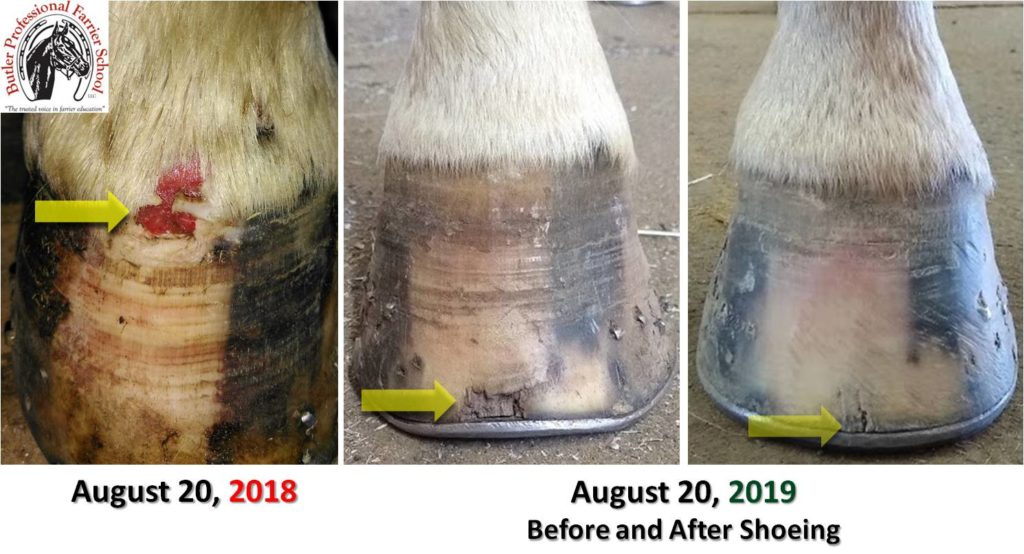Coronet Injuries
Horses’ hooves grow down from the coronary band to the ground at a rate of 1/4 to 3/8 inch per month (Butler 1976). At this rate, it takes approximately 8 months to a year for the horse to grow an entirely new hoof. When a horse injures itself near the coronary band, the evidence of the damage slowly grows out of the foot over time.
Last year, one of my horses stepped into a drainage pipe and cut the skin at the coronet. At first, the wound appeared to be deep; I feared that the coronary band had been damaged and the hoof growth would be affected. It turned out to be a superficial cut on the skin. This is evidenced by the growth of the hoof. One year later, as I trimmed and shod his foot, I noticed the remnant of the wound has almost entirely grown out. It would be similar to having a blood blister under your fingernail from some kind of trauma that then grows out over time.

Left: This horse cut the skin at the coronet. What appeared to be a deep wound turned out to be superficial and it slowly grew out as the horse was trimmed every 6 weeks for a year. Middle and Right: In exactly one year’s time, the horse has grown a new foot and the superficial wound has grown out.
In other cases, when a wound is deep and injures the sensitive coronary band, the growth source is damaged; therefore the hoof growth is distorted. These types of distortions usually never grow out. This can be compared to damaging your cuticle and as a result always having a ridge or other disfigurement in the fingernail.

This horse had an old wire wound on the rear part of his hoof. The distorted growth at the heel became painful when the horse put weight on it. The horse was shod with a Z-bar shoe and frog support to relieve pressure on the afflicted area. Because the injury is in the coronary band, the foot will consistently grow like this and require special attention.
In cases where the hoof growth is distorted because of a damaged coronary band, the hoof can grow down at an awkward angle and cause pain to the animal. If this is the case, the hoof must be shod therapeutically to relieve pressure or rubbing between hoof parts. If there is a loose portion of hoof growing down (like a perpetual hangnail), it may help to trim it back to prevent it from touching the ground or rubbing against another part of the solid hoof. Sometimes, polyurethanes, such as Vettec™, can be used to stabilize cracks or loose parts of the hoof. The goal is to relieve and prevent pain.
In some cases, a damaged hairline and distorted hoof looks ugly but does not affect the soundness of the horse. No therapeutic solution is necessary for these types of horses but they should still be trimmed and shod on a regular interval. Plastics may be used to cover up blemishes.
Of course, prevention is the best cure for anything, but some horses seem to be especially accident prone. When injuries do occur in the feet, it is important to understand where growth originates in order to successfully treat the horse. Understanding how the hoof grows, can help you explain to your clients how severe the damage may or may not be. If you’d like to learn more about how the hoof grows and more about the anatomy of the hoof in general, check out our Essential Anatomy video.
Related Posts
-
“The Butler Team” recently won the three-man draft horse...Jun 23, 2011 / 2 comments
-
-
If you want to work with horses and the people who value the...Sep 29, 2011 / 0 comments
Blog Categories
- Anatomy
- Best Business Practices
- Conformation
- Current Events
- Customer Service
- Draft Horse Shoeing
- Equine Soundness
- Essential Anatomy Kit
- Farrier Careers
- Farrier training
- Foal soundness
- Horse Care
- Horse Foot Care
- Horse Owner Tips
- Horsemanship
- Horseshoeing
- Horseshoeing History
- Iron and Forge Work
- Student Spotlight
- Uncategorized
- Veterinary Care
Blog Archives
Contact Us
Butler Professional Horseshoeing School
495 Table Road
Crawford, NE 69339
(800) 728-3826
jacob@dougbutler.com
Subscribe to Our Blog
Get Our Free e-Book!
If you think you want to become a farrier (or know someone who does), this book can help you make that decision. Horse owners will learn the importance of choosing a qualified farrier and how to select the “right” one.
[ Get the e-Book Now! ]
- Follow:
